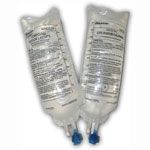 Commentary by Bani Chander MD, PGY-2, and Sergio Obligado MD, Attending Physician, Nephrology
Commentary by Bani Chander MD, PGY-2, and Sergio Obligado MD, Attending Physician, Nephrology
Tumor lysis syndrome (TLS) is characterized by a group of metabolic abnormalities including hyperkalemia, hyperuricemia, and hyperphosphatemia with secondary hypocalcemia, following the initiation of cytotoxic therapy. Although there is no well established definition for this syndrome, the Cairo-Bishop definition [1] is a commonly used classification system that stratifies the degree of severity by utilizing specific laboratory data and clinical features. The constellation of abnormalities that occurs in TLS is due to a rapid release of potassium, purine nucleic acids, and phosphorus when tumor cells abruptly lyse their contents into the extracellular space. These abnormalities can subsequently lead to acute renal failure and may result in multiple organ failure and/or death. It is therefore important to identify those patients who are at risk for this syndrome in order to initiate early preventative treatments [2], most often including a combination of allopurinol, IV hydration, and/or urinary alkalinization.
TLS is most often seen in acute lymphoblastic leukemia and high grade non hodgkins lymphoma, most commonly in Burkitt’s lymphoma [3]. Other common malignancies associated with TLS include CLL, AML, multiple myeloma, small cell lung cancer, breast and ovarian cancer, medulloblastomas, and sarcomas. The kidney is the primary organ involved in the clearance of potassium, phosphorous, and uric acid. Uric acid can precipitate in an acidic environment or if there is decreased tubular flow rate within the renal tubules. When uric acid crystals form, they can precipitate within the collecting ducts and ureters and can cause obstructive uric acid nephropathy. Calcium phosphate deposition in the renal collecting ducts, vessels, and ureters may also contribute to acute renal function in this setting.
Standard of care in patients who are to receive chemotherapy or radiation in a cancer with high cell turnover is at least 2 days of allopurinol prior to initiation of therapy. IV fluid hydration should also be used in order to maintain urine output at a minimum of 2.5 liters/day. More recently, rasburicase has been introduced and used to prevent uric acid nephropathy in patients who are at increased risk for tumor lysis syndrome. High risk features are characterized by increased uric acid levels, LDH levels greater than two times normal or WBC >50,000microL (both indicative of high tumor burden), certain tumors including Burkitt’s lymphoma, lymphoblastic lymphoma, ALL, AML, decreased intravascular volume status, and the presence of tumor infiltration in the kidney.
Early recognition of a fall in glomerular filtration or diuresis in patients with tumor lysis is critical, as prompt initiation of dialysis in this group can prevent both further renal deterioration as well as dangerous metabolic derangements. In contrast to most causes of acute kidney injury in which dialysis is initiated to treat the sequelae of decreased GFR (i.e. hyperkalemia, uremia, volume overload), dialysis can actually reverse the kidney injury, as both uric acid and phosphate are efficiently cleared by the dialysis membrane.
The role of urinary alkalinization in the tumor lysis syndrome remains controversial. Urinary alkalinization is typically achieved with either sodium bicarbonate or acetazolamide with a goal ph in the range of 6.5 to 7. The theory behind alkalinization is that it will convert uric acid to a more soluble urate salt, promoting the urinary excretion of urate and decreasing the likelihood that uric acid will precipitate in the renal tubules.While urine alkalinization has historically been considered a mainstay in the treatment of TLS [4], it has several potential limitations. In patients with pre-existing hyperphosphatemia, it can worsen hyperphosphatemia and promote calcium phosphate deposition in multiple organs, most notably in the heart and kidneys. Other potential problems include fluid overload and delay of treatment in patients, metabolic alkalosis, and the precipitation of xanthine obstructive uropathies (since the solubility of xanthine and hypoxanthine significantly decreases at a urine ph >6.5) [4].
To date, only one study has done a side by side comparison of urinary alkalinization with IV hydration alone. Conger et al.[5], using a rat model of acute urate nephropathy, compared the use of urine alkalinization with acetazolamide and isotonic NaHCO3 as compared to diuresis with saline and/or lasix as compared to no treatment at all. There were no significant differences between the groups and hydration with normal saline appeared to be just as effective as alkalinization for the prevention of uric acid precipitation. The authors of this study concluded that high tubular fluid flow, irregardless of the method of diuresis (solute vs. water diuresis), is the primary mechanism for protection in acute uric acid nephropathy. This study demonstrates that at most, urine alkalinization plays only a minor role in the prevention of acute uric acid nephropathy and is currently, no longer routinely recommended.
The role of newer agents in the prevention of tumor lysis syndrome is being explored. Numerous studies have reported the use of rasburicase (uricase) [2, 7-11], which when used in combination with hydration, appears to significantly benefit those patients at risk for TLS along with having a higher safety profile as compared to conventional treatments. Urine alkalinization is not needed in patients who are treated with rasburicase, and is now considered to be standard of care for those patients at high risk for TLS or in those with acute renal failure secondary to hyperuricemia [12]. Allopurinol and fluid hydration are generally still considered to be standard of care in those who are low risk. Ultimately, new therapeutic options are still needed for preventing TLS and for treating hyperuricemia, especially in those with pre-existing renal dysfunction.
